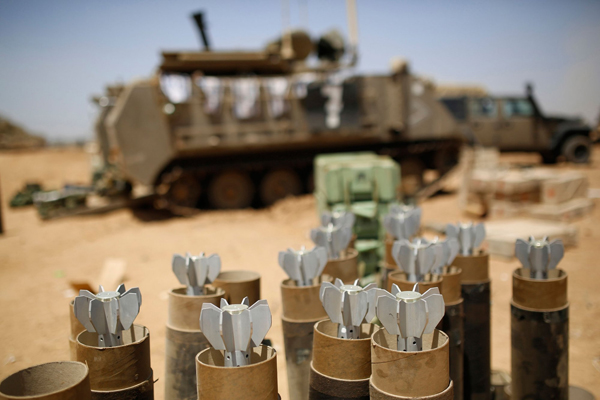Israel is the largest recipient of U.S. military assistance in the world—about $3.1 billion a year these days, and some $80 billion since the 1960s (without adjusting for inflation). As this war in Gaza drags on, Washington is committed to resupplying Israel with the weapons it needs to continue its assault. On July 30, the Pentagon, which stockpiles weapons in Israel, announced it was turning over large but unspecified quantities of 120mm mortar rounds (which were about to pass their shoot-by dates) to the Israeli military in a transaction so routine the White House didn’t even need to be notified. Except that there’s nothing routine about the Gaza slaughter. And that ammunition was needed by Israel to continue its offensive.
Maybe that’s why Palestinians were cynical when they heard U.S. Secretary of State John Kerry promise $47 million in emergency humanitarian aid to Gaza at the end of July. Uncle Sam giveth, and Uncle Sam taketh away. But in the midst of this, their third major war in a decade, Gazans know that where they are concerned there’s never remotely as much giving as there is taking away.
Some of Israel’s depleted stockpiles of 120mm mortars are now scattered about the war-scarred home of the Abu Hashish family. They fled the town of Al Atatra near the Erez crossing to Israel on July 17 as Israeli bombardment intensified. Karim Abu Hashish took his wife and four kids to an UNRWA school shelter on the edge of Beit Lahiya.
“What I don’t understand is why the Americans give us food and then give bombs to Israel to kill us.”
When Israel announced this week it was redeploying its ground forces in the area, pulling back, the Abu Hashishes were some of the first families to pile their clothes, pillows and flower-patterned mattresses into a taxi and attempt to return home. The overcrowded school where the family had sought refuge was a scene of despair and squalor. Donkeys and horses crowded around the school’s outer walls and broken water mains flooded the animal waste into the streets where hundreds of displaced kids tried to play. The families there wanted to go home whatever the cost.
But as the Abu Hashish family entered the eerie ghost town of shattered one-story homes around Al Atatra, they realized moving back while the war still raged might be a fatal mistake. Karim Abu Hashish bolted through his front door to find 120mm mortar rounds had punctured the walls and destroyed the rooms of his home.
Karim is a loyal member of the Fatah faction of Palestinians and a former employee of the Palestinain Authority (so he is among the “good guys” as far as Washington is concerned). But Karim has been without work since Hamas seized power in Gaza in 2007 and Israel imposed its seven-year blockade. He doesn’t begin to have the resources to fix the shrapnel damage to his roof from the last Gaza war in 2012.
“It will take time to comprehend what’s happened here,” says Karim, standing in front of a Fatah poster in his small, dust-filled living room with a gaping hole in the wall. “Maybe we will stay the night, maybe we will flee back to the school,” he said. An hour later, Israel shelled Al Atatra again.
For many Gazans, Israel’s use of U.S.-supplied weapons to destroy their lives and kill their friends and relatives is a reality they resigned themselves to long ago. While there is anger at America as Israel’s enabler, there is more indignation at the hypocrisy of Washington offering aid to their maimed society, crippled with the help of Washington’s weaponry.
In the flattened north-Gaza town of Beit Hanoun, 24-year-old Tamer al Masri stands outside his family apartment next to his living room. The front wall is gone. It looks like a makeshift proscenium, the stage for what used to be his life. Tamer’s 10-year-old brother sits on a couch inside as neighbors and family pick through debris. Underneath the rubble is the other al Masri brother, an Al Qassem fighter who stayed after residents evacuated to try to slow Israel’s advance into Gaza.
“We have known about the use of U.S. weapons for a very long time,” he says, unfazed by America’s role in the death of his brother. “What I don’t understand is why the Americans give us food and then give bombs to Israel to kill us.”


